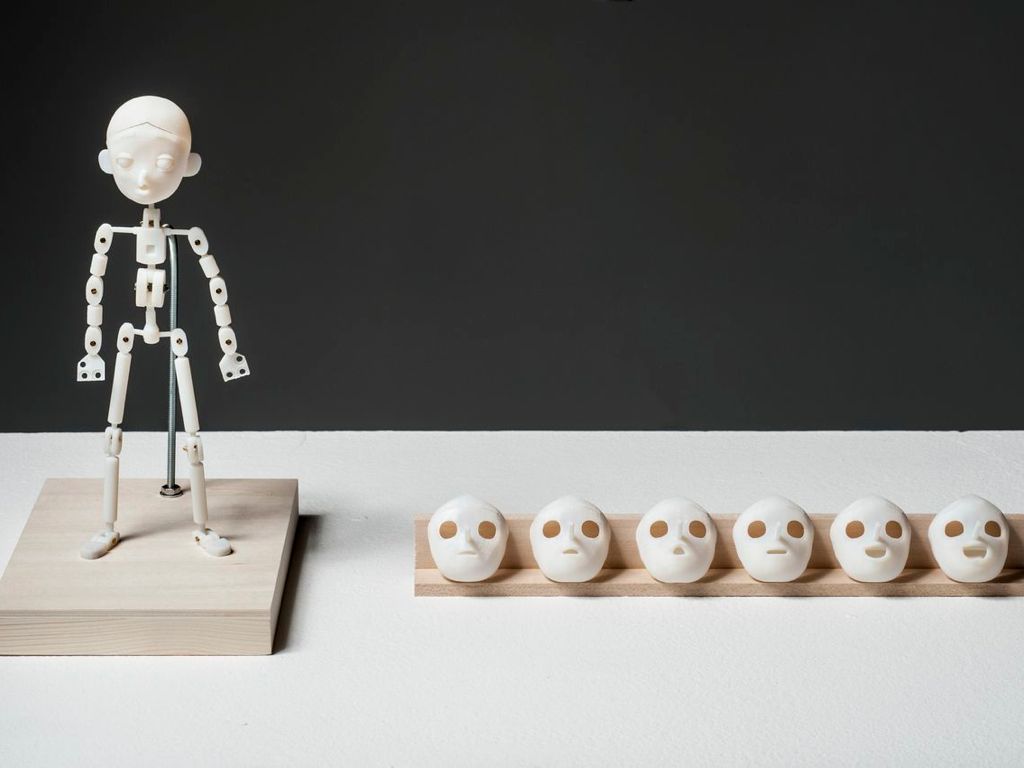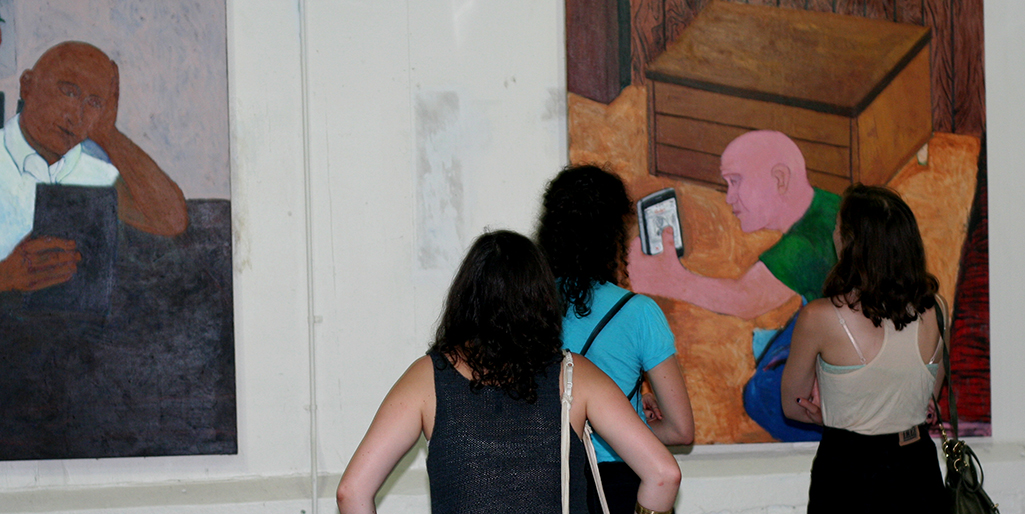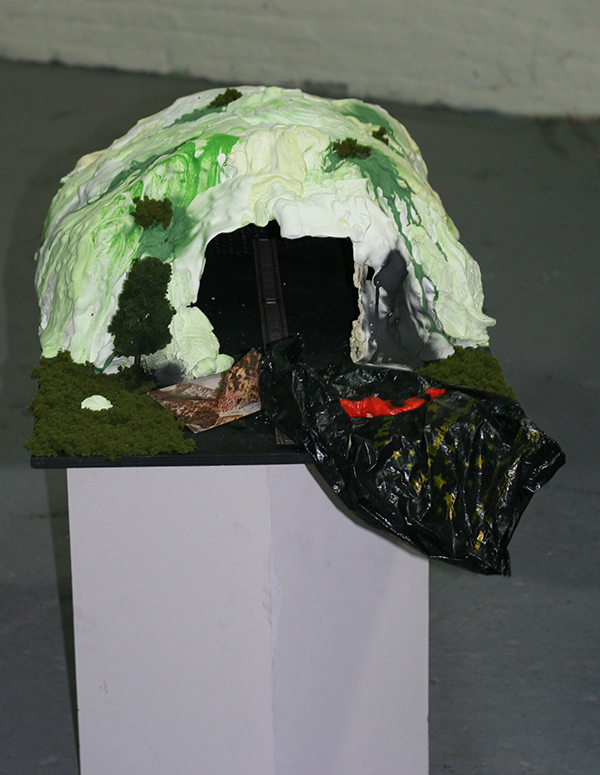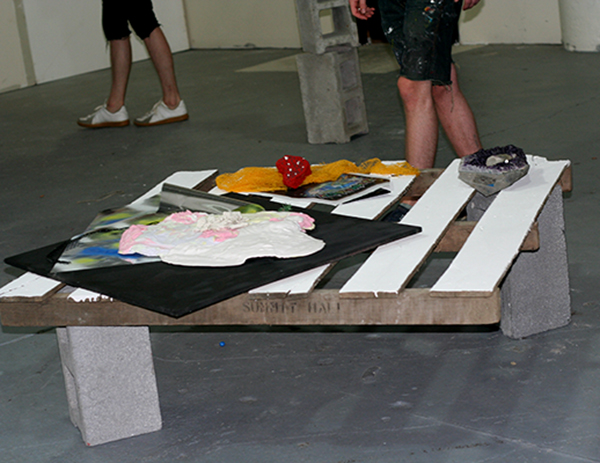Review by Jack Livingston of Bald Ego: New Work by Killian Barnes, Rachel Lowing, and Alexander Shaw @ The Annex 2E
There is good bad art and there is bad good art. There are other kinds of art, but for purposes of this review we are talking about these two categories. The king example of good bad art is Julian Schnabel. He is widely detested among detractors for his haphazard, often awkward, work and arrogant nature, but his art is good bad because it rings true, is original, and can fill a museum and stand up to the work of the past or present—and I like it and this is my review. Philp Guston is another classic good bad artist, or was thought to be when he started his figure series. Now he is so lionized as a great artist, people have forgotten the bad part. George Condo is an example of a current good bad painter.
In contrast, bad good are artists are those whose work really is bad and disappointing, yet is thought to look good and holds the party line in whatever the flavor of the year is. In this category I would put Eric Fischl, David Salle and about 75 percent of the art made any in any time or place. Once you frame art in this way it becomes a really fun game. Which category is Richard Prince, Tracy Emin or John Curin in? How about David Hockney? You can also consider music— Grateful Dead, Fleet Foxes, Devo, Red Hot Chili Peppers, Rush? Poetry? OK, how about Bukowski, Allen Ginsberg, Patti Smith, and lets toss in Ron Padgett? Fun huh? I am using older artists names here because we have some perspective from which to judge.
I am writing about this because I went to an exhibition a couple of weeks ago and was pleased to see an entire show made by young artists who were gleefully making good bad art. It was awkward, goofy, reactionary, and yes, good. Maybe I was reeling from a Sondheim exhibition hangover, where, in both the finalist and semi-finalists exhibit, contemporary formalism reigned supreme and a strict adherence to the lofty goals of smart-looking, high concept, well made contemporary art was maintained. There was little that was messy. If it were a church, it would have been Protestant, with clean lines, no frills, and for the most part, chilly. Like any good parishioner, after too much church I was in need of some serious sin.
The sin-filled gallery with the necessary messy badness I happened upon is called The Annex 2E, an artists studio space that operates as a gallery, too. This creation of a casual gallery is a time-honored activity in our city. Each generation seems to decide when it is time to create a new space for their friends. It is usually when they feel they will not be represented in the existing system. Of course, they are all just semi-legal in the beginning and may remain so, but it is generally the places the most interesting art is happening in Baltimore at any given time. Think Gallery Four, which ushered in professionalism not before seen and serious regional curating. Think Nudashank, which was carefully curated to at first to mix it up with young international artists via connections made on the web, then soon after became a direct pipeline to the work of young artists from Brooklyn. Think Current, Sophia Jacob, Area 405, and so many more that have carved out new arenas with an esthetic that is very much their own. Our city’s art scene thrives on these spaces.

Annex 2E sits at the end of Oliver Street just east of Area 405, around the side of a studio filled brick building and up a steep flight of metal fire escape stairs. You head in through a small door on the second floor, which seems intentially obscure, as if it were a members only club. It isn’t marked with any kind of signage inside or out. Inside, while painted the usual white and cleared of mess, it is in no way slick.
I stumbled on the Annex 2E Gallery show by accident. I was on my way to see the exhibition at Springsteen when I became aware of a steady steam of young art types heading the opposite direction down Oliver street. I saw a friend among them who informed me of the show and said Springsteen was at that moment very crowded and hot and he was going to check the new place out, so I turned around and followed the crowd.
Inside was a group of works that flounder around and would most likely not make the grade into a usual curated show. However, here in this setting, the work had a collective exuberance that only young artists at a certain stage possess before the art world sucks it out of them and forces them to pursue loftier, more mature goals. The show is similar to any small group of precocious students who have taken over a space at school eager and are ready for a crit. As a visiting artist, I have seen have seen some of my favorite shows in these situations, because authenticity is in the air and the artist’s heart is in their work, no matter how mixed up or misguided their approach. Their work, a result of late nights, boozy conversations, and a number of hours of toiling away on their own, is often breathtaking in its earnest honesty.
There was a problem with this whole ad hoc mystery gallery thing though. There was no information, no statements, not even names on the work I could see. I had to hang around the work, gazing and taking photos before I figured out any one artist. I finally did when painter Killian Barnes’ grandfather (I think) ran into me—literally— and then asked me to explain the paintings to him because he said they were not his “cup of tea.” I did a quick positive crit of the painting. This wonderful conversation could be a review in itself about meeting artists’ relatives and hearing their views—this one ended up with a discussion that compared Perry Como and Frank Sinatra and their careers. I then had the inside connect to get the artist and his family together for a picture. They were a lovely bunch.
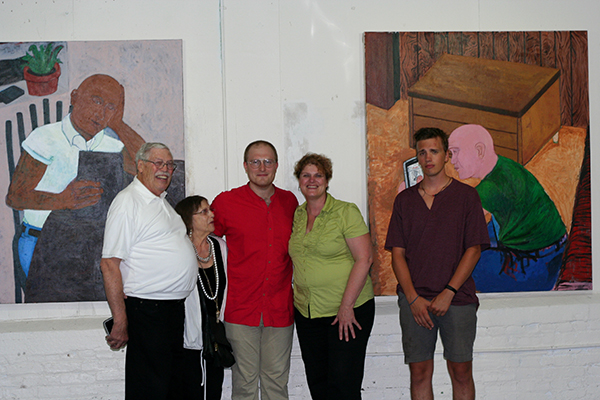
Barnes’ work dominated the show because there were lots of them and they are big and clumsy looking with layers of acrylic used to render narratives that one assumes come from the artist’s still somewhat boyish life. They vaguely reference our relationship to technology but not in any significant way. Their power is in the springtime “testosterone-lite” themed short stories they tell, accentuated by odd choices of composition, and paint application. My favorite was a simple painting of a boy stumbling down the stairs with a bulging bag in hand, his home a mess, with socks and underwear laying askew on the floor. A large cassette tape, a connection to the taste for nostalgia by way of retro-analog forms of sound that is in vogue, is visible, along with some scattered envelopes on a table. The figure in the painting is cropped at the chest so we don’t see a face, with the oversized hands painted lumpy. The perspective is askew, but not obviously so. The piece is sweet and beguiling, like seeing a secrete snapshot of one’s kid out on his own making his way in the world rushing about still in a lair of stinky boy mess.
The other paintings continue in this vein, funny and haphazard with a thick-thin layered painting surface that successfully manages to both get fun-muddy, but remain colorful. The best painting from a critical point of view is of a nude figure, distorted and tall, sitting on a toilet viewed from behind. First of all, this is a strange vantage point we never see, except maybe in institutions. Here the artist has caught the full fleshiness of the body in a Leon Goleb meets Philip Guston way. It may be a humorous riff on Francis Bacon with all the bite removed and replaced by fart jokes. It uses a very odd, yet successful, composition with clever curving negative space—all to create a commanding painting presumably of a man taking a dump. What’s not to love about that?
Overall, Barnes’s work is of humanistic narratives, filtered through the eyes of a nebbish comedian. The figures represent the everyman or, in this case, the post-pubescent everyman. They bring to mind beat poet Gregory Corso’s humorous existential goof definition of the human race as “Big hairy bags of water that, when poked with a stick, leak.”
Throughout the gallery, while looking at the paintings you had to maneuver around an installation by Rachel Lowing that included a number of haphazard looking stacks or groupings of common objects made of contrasting bright and grey colors with random splotches of black spray paint. They are placed in a precarious totem like fashion on cinder blocks or small gallery cube stands on top a cardboard box, or lay low across the floor. There are some with lumpy material that looks foam like and blobbish, and other assortments of mundane random (or are they?) objects that seem forlorn and devoid of meaning on their own.
Again, on first glance they are bad and easily dismissed, but when circled, and with some time, they make more sense as differing connections and relationships occur. All disparate parts work together to form a successful abstract connected but dissociative set of sculptures, except for one, which is quite different. It is a plaster religious statue of an angel, painted black but now scuffed and chipped, sitting atop a cement blocks rising to about four feet. Is it meant to be poignant or is it a wry joke, a bruised heavenly spirit overseeing the other melancholy orbiting cracked piles of junk? It is hard to tell. Either way it works. Her stacked group installation/sculpture reclaims the special nature of the common place. Here she forces the viewer to be in the moment, to recognize the special interconnected nature of the mundane materials.
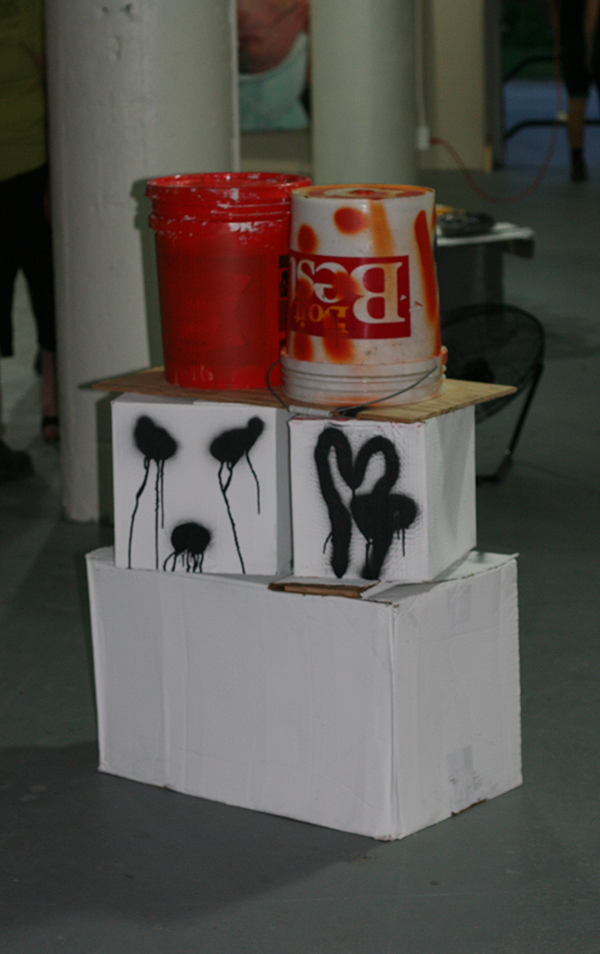
Before I left, I was introduced to the artist so I could take a photo. It was late and she seemed too preoccupied for questions and to be honest I didn’t want the answers, as they might ruin my own takeaway of her work. No explanation was offered in the show and I took that as a statement of the exhibition in and of itself. A good one, as the viewer got to decide what they wanted. I like this freedom and the artist’s willingness to let it be. It is an approach others should more frequently consider.
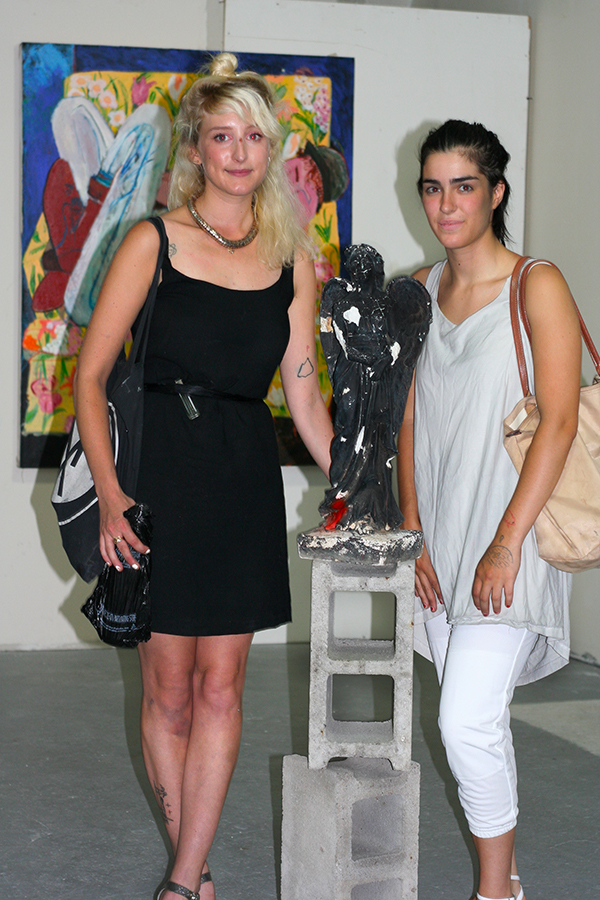
Finally, maybe the most accomplished of the three artists on first glance and also the easiest to categorize and like is Alexander Shaw, who uses what appears to be ink to rapidly sketch paint images of big goofy heads on paper and then assign them silly names like Skeatin, Plinko, or Resnik. They have a strong connection to alternative comic book art and other such pop styles, as well as to Neo-Expressionism. They are fun to look at and the artist has control over his process, yet in hindsight they are less memorable than the other work, especially that of Ms. Lowing who took more risks and is much less glib. Still, the heads add a special glint of insider humor and solidity that completes the good bad cycle the exhibition hinges on.
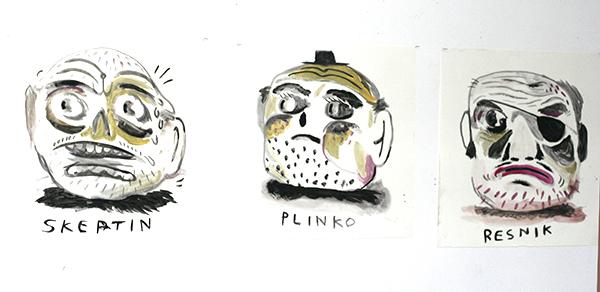
After a while I did get the opportunity to meet the curator Isa Gonzalez, who I spoke to briefly enough to get her email address that then proved appropriately useless and as such simply furthers the thesis of this review. Later, Gonzalez emailed me the artist’s names and pointed me to a review on Baltimore Fishbowl, though it presented some inaccurate information, but this is where I finally learned the title of the exhibition is aptly BALD EGO. A classic good bad title!
(Reviewer’s note: Later after this review was written the curator e-mailed me an offer of further information, but it was declined to keep the nature of the review intact. )
In the late seventies to early eighties, there was a time when “bad art” became a recognized movement. In retrospect it came out of the need to pull art from the conceptual mire it was stuck in and allow artists to have some fun again, plunging ahead without needing to explain everything from their academic ivory tower learning.’ There was even a large East Coast exhibition at the time appropriately titled “Bad Painting” curated by the renowned Marica Tucker. It featured work by seventeen largely unknown artists including Earl Staley of Texas. I lived in Houston, Texas then, and saw the style catch fire as it ran rampant through the art department at the University of Houston, spilling work into the alt space community, where residue remains there to this day. As such, I have a particular fondness for it. It was the precursor to Neo-Expressionism, the style that came to dominate New York painting in the eighties.
The artists showing at Gallery 2E may take offense at me lumping them in this category, but they should not because the good bad art I am categorizing them with has deep and important roots in fluxus, punk and DIY movements—arguably the most important counter culture categories of the past 40 years. It is a ‘go your own way’ kind of thing, a diversity that eschews art school/gallery/institutional refinement for something more genuine, flexible, independent, and immediate and that is very very good indeed.
BALD EGO: New Work by Killian Barnes, Rachel Lowing, & Alexander Shaw
July 11-18
The Annex 2E @ 419 east Oliver St.
Author Jack Livingston is a Baltimore-based artist, writer, and editor.

